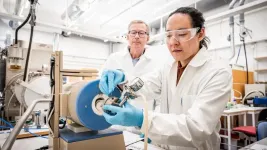(Press-News.org) HOUSTON and TÜBINGEN, Germany ― The University of Texas MD Anderson Cancer Center and CureVac N.V. today announced a co-development and licensing agreement to develop novel mRNA-based cancer vaccines.
The collaboration creates strong synergies between CureVac’s unique end-to-end capabilities for cancer antigen discovery, mRNA design, and manufacturing and MD Anderson’s expertise in cancer antigen discovery and validation, translational drug development, and clinical research. The collaboration will focus on the development of differentiated cancer vaccine candidates in selected hematological and solid tumor indications with high unmet medical need.
"We look forward to collaborating with the team at MD Anderson to push the boundaries of mRNA technology and develop impactful therapeutic options for patients in need," said Alexander Zehnder, M.D., chief executive officer of CureVac. “In combining our respective expertise, we believe we can go further and faster to develop novel, off-the-shelf, mRNA-based cancer vaccines that have the potential to significantly improve patient outcomes.”
Both parties will contribute to the identification of differentiated cancer antigens based on whole genome sequencing combined with long- and short-read RNA sequencing and cutting-edge bioinformatics. Joint preclinical validation of the highest-quality cancer antigens will be supported by Sachet Shukla, Ph.D., assistant professor of Hematopoietic Biology and Malignancy and director of the department’s cancer vaccine program, and by MD Anderson’s ECLIPSE (Evolution of Cancer, Leukemia, and Immunity Post Stem cEll transplant) platform, part of the institution’s Therapeutics Discovery division.
“We are excited for cancer vaccines to potentially emerge as an essential therapeutic tool in the future,” Shukla said. “This collaboration with CureVac is an important milestone in our efforts and brings together complementary strengths toward our goal of developing transformative vaccines for cancer.”
Following selection of the most promising clinical-lead vaccine candidates and completion of Investigational New Drug (IND) approvals, MD Anderson will be responsible for conducting initial Phase I/II studies in appropriate clinical indications.
“Our ECLIPSE team uses proprietary high-throughput technology to identify and validate immune targets, and we are driven to advance impactful immunotherapies with the potential to transform the lives of patients with cancer,” said Jeffrey Molldrem, M.D., chair of Hematopoietic Biology and Malignancy and leader of the ECLIPSE platform at MD Anderson. “Together with CureVac, we hope to embrace this exciting area of drug discovery and development in pursuit of mRNA vaccines that will address significant unmet medical need.”
Under the terms of the collaboration agreement, CureVac and MD Anderson will jointly contribute to and support development of those programs designated to move forward. CureVac has worldwide exclusive rights to late-stage development, commercialization, or partnering of the cancer vaccine candidates. MD Anderson is eligible for certain downstream payments based on potential future commercialization.
Read this press release in the MD Anderson Newsroom.
- 30 -
About CureVac
CureVac (Nasdaq: CVAC) is a global biopharmaceutical company in the field of messenger RNA (mRNA) technology, with more than 20 years of expertise in developing, optimizing, and manufacturing this versatile biological molecule for medical purposes. The principle of CureVac’s proprietary technology is the use of optimized mRNA as a data carrier to instruct the human body to produce its own proteins capable of fighting a broad range of diseases. In July 2020, CureVac entered in a collaboration with GSK to jointly develop new products in prophylactic vaccines for infectious diseases based on CureVac’s second-generation mRNA technology. This collaboration was later extended to the development of second-generation COVID-19 vaccine candidates, and modified mRNA vaccine technologies. Based on its proprietary technology, CureVac has built a deep clinical pipeline across the areas of prophylactic vaccines, cancer therapies, antibody therapies, and the treatment of rare diseases. CureVac N.V. has its headquarters in Tübingen, Germany, and has more than 1,100 employees across its sites in Germany, the Netherlands, Belgium, Switzerland, and the U.S. Further information can be found at CureVac.com.
About MD Anderson
The University of Texas MD Anderson Cancer Center in Houston ranks as one of the world's most respected centers focused on cancer patient care, research, education and prevention. The institution’s sole mission is to end cancer for patients and their families around the world, and, in 1971, it became one of the nation’s first National Cancer Institute (NCI)-designated comprehensive cancer centers. MD Anderson is No. 1 for cancer in U.S. News & World Report’s “Best Hospitals” rankings and has been named one of the nation’s top two hospitals for cancer since the rankings began in 1990. MD Anderson receives a cancer center support grant from the NCI of the National Institutes of Health (P30 CA016672).
END
PULLMAN, Wash. – Some of the world's deadliest bacteria seek out and feed on human blood, a newly-discovered phenomenon researchers are calling “bacterial vampirism.”
A team led by Washington State University researchers have found the bacteria are attracted to the liquid part of blood, or serum, which contains nutrients the bacteria can use as food. One of the chemicals the bacteria seemed particularly drawn to was serine, an amino acid found in human blood that is also a common ingredient in protein drinks.
The research finding, published in the journal eLife, provides new insights into how bloodstream infections ...
New research from the University of Pittsburgh explains why metastatic uveal melanoma is resistant to conventional immunotherapies and how adoptive therapy, which involves growing a patient’s T cells outside the body before reinfusing them, can successfully treat this rare and aggressive cancer.
In a paper published today in Nature Communications, the Pitt researchers also explain how they developed a new clinical tool that predicts which patients will respond to adoptive therapy. The work, supported by UPMC Enterprises, is helping improve personalized therapies and avoid futile treatments for metastatic uveal melanoma.
“The dogma was that uveal melanoma is ...
New research from King’s College London has found that spaces with a diverse range of natural features are associated with stronger improvements in our mental wellbeing compared to spaces with less natural diversity.
Published in Scientific Reports and funded by the National Institute for Health and Care Research (NIHR) and Wellcome, this citizen science study used the smartphone application Urban Mind to collect real-time reports on mental wellbeing and natural diversity from nearly 2000 participants.
Researchers found that environments with ...
For the first time, scientists have managed to create sheets of gold only a single atom layer thick. The material has been termed goldene. According to researchers from Linköping University, Sweden, this has given the gold new properties that can make it suitable for use in applications such as carbon dioxide conversion, hydrogen production, and production of value-added chemicals. Their findings are published in the journal Nature Synthesis.
Scientists have long tried to make single-atom-thick sheets of gold but failed because the metal’s tendency to lump together. But ...
Nineteen out of 34 countries surveyed failed to fully meet their 2020 climate commitments set 15 years ago in Copenhagen, according to a new study led by UCL researchers.
The study, published in Nature Climate Change, compared the actual net carbon emissions of more than 30 nations to their 2009 pledged emission reduction targets set during the Copenhagen Climate Summit.
The paper led by researchers at UCL and Tsinghua University is the first effort to comprehensively gauge how well countries were able to meet their Nationally Determined Contribution reduction pledges from COP15.
Of the 34 nations analysed in the study, ...
Optical neural networks may provide the high-speed and large-capacity solution necessary to tackle challenging computing tasks. However, tapping their full potential will require further advances. One challenge is the reconfigurability of optical neural networks. A research team in the Stiller Research Group at the Max Planck Institute for the Science of Light, in collaboration with the Englund Research Group at the Massachusetts Institute of Technology, has now succeeded in laying the foundation for new reconfigurable neuromorphic building blocks by adding a new dimension to photonic machine learning: sound waves. The researchers use light to create ...
BOSTON, MA – A new study led by the Harvard Pilgrim Health Care Institute has identified that a deficit in the placental expression of the gene insulin-like growth factor 1 (IGFBP1) and low IGFBP1 circulating levels are associated with insulin resistance during pregnancy, highlighting a potential risk factor for the development of gestational diabetes.
The study, “Placental IGFBP1 levels during early pregnancy and the risk of insulin resistance and gestational diabetes,” appears in the April 16, 2024 edition of Nature Medicine.
Gestational diabetes, a disease that can lead to multiple pregnancy and delivery complications, is the most common pregnancy ...
University of Leeds news
Embargo: Tuesday 16 April, 2024, 10am UK time
Care home staff and residents need ‘family’ bonds to thrive
Care home residents receive much better care when they enjoy ‘family’ bonds with staff – but staff must be empowered to create these bonds, new research has found.
The study, led by the University of Leeds and funded by The National Institute for Health and Care Research, found that when care home staffing is stable and consistent and numbers are sufficient, workers have the capacity to develop ‘familial’ ...
Patients with suspected inflammatory bowel disease (IBD) could benefit from better testing protocols that would reduce the need and lengthy wait for potentially unnecessary colonoscopies, a new study has found.
In a paper published in Frontline Gastroenterology, researchers from the Birmingham NIHR Biomedical Research Centre (BRC) at the University of Birmingham tested a new protocol to improve IBD diagnosis combining clinical history with multiple home stool tests.
In the two-year study involving 767 participants, patients were triaged and had repeated faecal calprotectin (FCP) tests and the research team found that the use of serial FCP tests were able to strongly predict possible ...
Astronomers have identified the most massive stellar black hole yet discovered in the Milky Way galaxy. This black hole was spotted in data from the European Space Agency’s Gaia mission because it imposes an odd ‘wobbling’ motion on the companion star orbiting it. Data from the European Southern Observatory’s Very Large Telescope (ESO’s VLT) and other ground-based observatories were used to verify the mass of the black hole, putting it at an impressive 33 times that of the Sun.
Stellar black holes are formed from the collapse of massive stars and the ones ...




